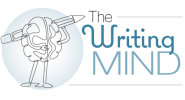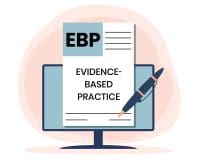It’s stating the obvious that nurses are very busy, but it’s worth considering the impact of that busyness on authors who want to have their published articles read. The primary impact from an author’s perspective is that you have to compete with many factors—both personal (such as driving the carpool) and professional (such as chronic short staffing)—to gain readers’ attention. To succeed in that competition, your article must entice readers to decide it’s worth their time to squeeze your article into their hectic lives.
One strategy for enticing readers is the graphical abstract (GA; also called visual abstract), which provides a succinct visual representation of an article. GAs combine text and visuals to summarize key points of an article. Think of them as extended movie trailers with a bit more plot details. The goal is to draw readers into the story of your article.
Many medical journals now require a GA to be included with an article, others make them optional. Nursing journals have lagged in this area, but that doesn’t mean you shouldn’t create a GA, which can be shared on your or the publication’s social media platforms to promote your work and enhance dissemination.
Creating a GA
Many journals that use GAs have specific requirements (such as acceptable fonts and file types), so check the author guidelines before starting. These three steps can help keep you focused on your creative journey.
- Identify your main messages. Ask yourself, what are the most important points you want the reader to take away. Remember, GAs are meant to be succinct, so keep to one or two points. If you’ve written a research article, you might want to give a brief overview of methodology and results to support the message.
You also should craft the message so it best fits your target audience. For example, your GA about the results from your study will differ between professional colleagues and the general public.
- Choose your design. The most common design features a title at the top, with the key message below, and then three panels (read left to right) under that. The section below the panels contains a link to the article with basic citation information. Here’s an example from Elsevier:
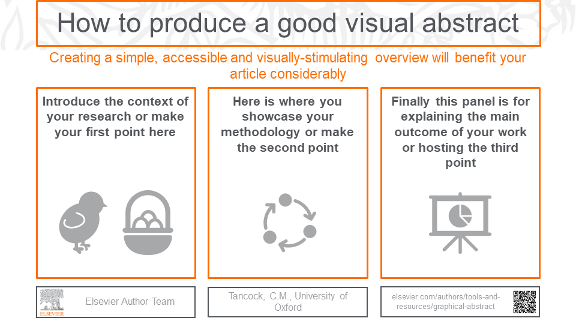

Another option is to start at the top with the title and key message, then have boxes meant to be read from top to bottom below, and again, end with a link to the article.
Other formats can work too, depending on the topic. For example, an article on the history of critical care nursing might use a timeline or an article on giving feedback might use a circular flowchart. Here are two sample templates from Simplified Science that illustrate different formats.
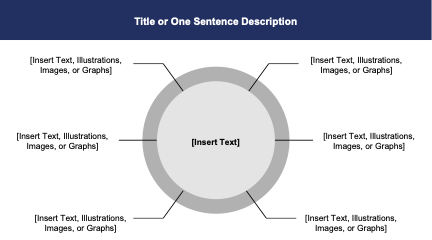

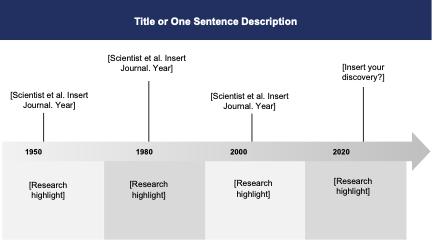

You may want to sketch out your GA first to see if it is a good fit with your chosen design. Remember, you want the reader to be able to easily follow the content of the GA.
- Enter text and images. Keep text short and images and illustrations simple. You want to catch readers’ eyes and give them an interesting point or two so they will seek out the full article. Use a standard font such as Arial, Times, or Helvetica. Color is good, just don’t overdo it.
Once you complete the GA, proof it carefully and ask for feedback from those who have (and have not) read your article.
Here’s a nice visual that outlines the elements of GAs for a research article (see Ibrahim reference).
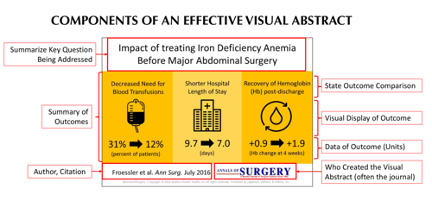

Design help
Several tools exist to help create a GA, including Microsoft PowerPoint, Mind the Graph and Canva (the last two offer a free basic service, then subscription options). You can download free templates in Adobe Illustrator and PowerPoint from Simplified Science, which also has free tutorials.
Sources for free images include the Public Health Image Library, the National Institutes of Health, US Department of Health and Human Services Image Galleries, and Wikimedia Commons. The Noun Project offers free icons in addition to paid options. Even for free images, you should credit the source.
When sharing your GA on social media, keep in mind that you may need to resize it to fit the platform. For instance, images on Instagram need to be more of a square format compared to LinkedIn. Simplified Science provides examples.
Get started
Creating GAs gives you the opportunity to be creative, while providing another avenue for disseminating your work. I encourage you to give them a try!
References
Alexander M. Organizing the article. In: Saver C. Anatomy of Writing for Publication for Nurses. 4th ed.Indianapolis, IN: Sigma Theta Tau International; 2021;67-79.
Elsevier. Graphical abstracts. 2023. elsevier.com/authors/tools-and-resources/visual-abstract
Ibrahim AM (Ed). Use of a visual abstract to disseminate scientific research (Version 4). 2018. static1.squarespace.com/static/5854aaa044024321a353bb0d/t/5a527aa89140b76bbfb2028a/1515354827682/VisualAbstract_Primer_v4_1.pdf
Lee J, Yoo J-J. The current state of graphical abstracts and how to create good graphical abstracts. Science Editing. 2023;10(1):19-26.
Martin K. A picture is worth a thousand words. Medical Writing. 2020;29(1): 28-34.
Pavlovich-Danis SJ. All about graphics and tables. In: Saver C. Anatomy of Writing for Publication for Nurses. 4th ed. Indianapolis, IN: Sigma Theta Tau International; 2021;93-108.
Royse M. How to get your readers to actually read your articles. Writing Cooperative. March 9, 2021. writingcooperative.com/how-to-get-your-readers-to-actually-read-your-articles-7a313b377291


I’ve been a full-time professional nurse writer and editor for many years, and that doesn’t count the writing I did as I fulfilled my nursing roles in clinical, research, education, and management. My passion is helping nurses share their expertise through the written word, including, but not limited to, publication. Writing can be scary and intimidating. I hope to make it less so and to help you develop your writing skills the same way you’ve developed your nursing skills.
Whether you’re considering your first or your 50th publication, want to contribute to your organization’s newsletter, or crave to be a better communicator online and in print, I hope you’ll find what I write helpful. The nurse publishing colleagues I’ve learned from over the years (many of whom are contributors to my book) may not be listed by name, but I’m grateful for their willingness to share. In that spirit, I’m looking forward to sharing with you! If you have feedback, feel free to email me at csaver57@gmail.com.

